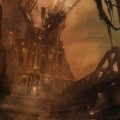The second developer diary for Aliens: Infestation has been published today. As previously announced here, this entry focusses on the gameplay and some of the game mechanics. You can read the full thing at the Sega blogs.
“Our xeno spawn systems helped elevate that unease even further. Basically, the two primary ways that xenos can appear in this game are: slinking out of the shadows, or popping out from the floors/ceilings. The first approach is a subtle, uneasy entrance. A xeno is wedged into the architecture (as it was in the final scene of Ridley Scott’s alien). The player knows it’s there…or do they? The hidden xeno will remain lodged in the wall, completely still, illustrated in a way that matches the sci-fi art style of the environment.“
In addition to this, nine new screenshots from Infestation have been uploaded online. Click here to see them. Thanks to Sega PR for the news.


http://www.gearboxity.com/content/view/760/33/